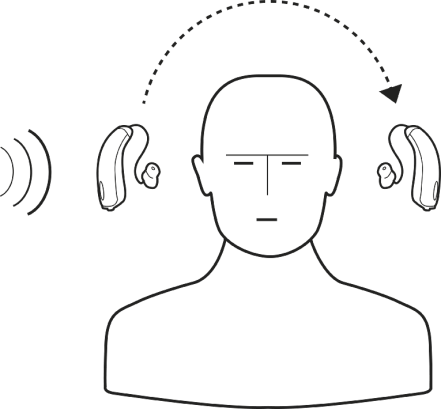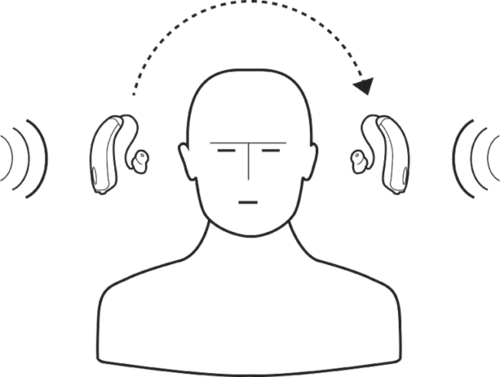Single sided deafness, there is a solution
Single sided deafness (SSD), is a little known condition generally, however, it actually affects 60,000 people each year in the United States alone. According to a study by doctors in the UK, awareness about and understanding of SSD is limited even in the greater medical community in that country:
Awareness of SSD and its symptoms are inevitably low … This results in limited or delayed referral and diagnosis, and often the failure to provide support for patients.
Single sided deafness is something that we often come across in our Practice. In the case of true single sided deafness traditional hearing aids are not an option. Typical single sided deafness presents as complete or near total deafness in one ear. The other tends to have little or no loss. There is a solution though, CROS or BI-CROS hearing aids. This is why we have included modern CROS systems in hearing aid offerings in our hearing aid centres in Cork, Waterford, Kilkenny & Tralee.
What is Single Sided Deafness?
Single Sided Deafness involves damage to the hearing in one ear only. This is normally a severe or complete loss of hearing in that ear. This type of hearing loss is usually caused by disease or accident. It can present at birth or at any time after, dependent on the cause.
The Problems With SSD
People with SSD have difficulty understanding speech in any situation with background noise. This is caused by localisation difficulties, the brain uses the inputs from two ears in locating the origin of sound. Because of this the brain of someone with SSD has real problems separating background noise from speech. People with SSD also have difficulty hearing anyone on the side that they have the problem on, this leads to them having to fully turn their head to have conversations with mor than one person.
Social Problems With SSD
Single Sided Deafness can lead to problems hearing and understanding both at work and at home. It can have both a social and financial impact on a sufferer. In a UK study, 24 percent of people with the condition had to give up work. I think that figure shows the stark impact that this condition has on the lifestyle and livelihood of people who suffer from it. Not surprisingly some people reported feelings of social isolation and exclusion.
No Cure But Options
While there is no cure for Single sided deafness, there are options available to help. These hearing aid systems are called CROS or BI-CROS and are specially designed to help with SSD. We use hearing systems from Phonak and Widex which wirelessly transmit sound from the deaf ear to the better ear. The systems use one hearing aid as a transmitter, which is placed behind the deaf ear. The transmitter picks up sound from that side of the head and wirelessly transmits it to a receiver hearing aid on the normal-hearing ear. This solution is discreet and requires a non-invasive fitting procedure.
Solutions for Single Sided Deafness:

CROS
WIDEX CROS hearing aids systems wirelessly transmit sound from the side with hearing loss to the side without hearing loss via a transmitter, which is placed behind the deaf ear. The transmitter picks up sound and wirelessly transmits it to a receiver hearing aid on the normal-hearing ear.

BiCROS
WIDEX Bi-CROS hearing aids system wirelessly transmits sound from the side with severe hearing loss to the side with better hearing via a transmitter, which is placed behind the deaf ear. The transmitter picks up sound and wirelessly transmits it to a receiver hearing aid on the normal-hearing ear.
BAHA Systems
The BAHA system or Bone Anchored Hearing Aid, is a semi-implantable bone-anchored hearing device. The anchor of the BAHA system is installed during a surgical procedure. The procedure is undertaken under general anaesthesia, so it is not an option taken lightly. BAHA systems have a high success rate, however they are exceptionally visible. A wireless CROS or BiCROS system is far more discrete and much less obvious than BAHA and involves no surgery.
How do CROS and BiCROS systems help people with Single Sided Deafness?
CROS and BiCROS systems help people with SSD to better locate and distinguish sounds which leads to benefit in a host of situations in particular in background noise. In a recent Widex study, researchers found that the specific situations in which the test subjects rated the improvement with CROS to be the most significant in these three very common situations:
-when following a conversation in the presence of background noise
-when having a conversation while driving a car
-when participating in a group conversation
We are currently fitting both the Widex and Phonak CROS system to some of our Patients and we are getting really good results. If you have any questions about single sided deafness or CROS hearing aids, give us a call on 1800 501 501
References:
“Hear the Other Side: A Report on Single Sided Deafness”








0 Comments
Add Comment